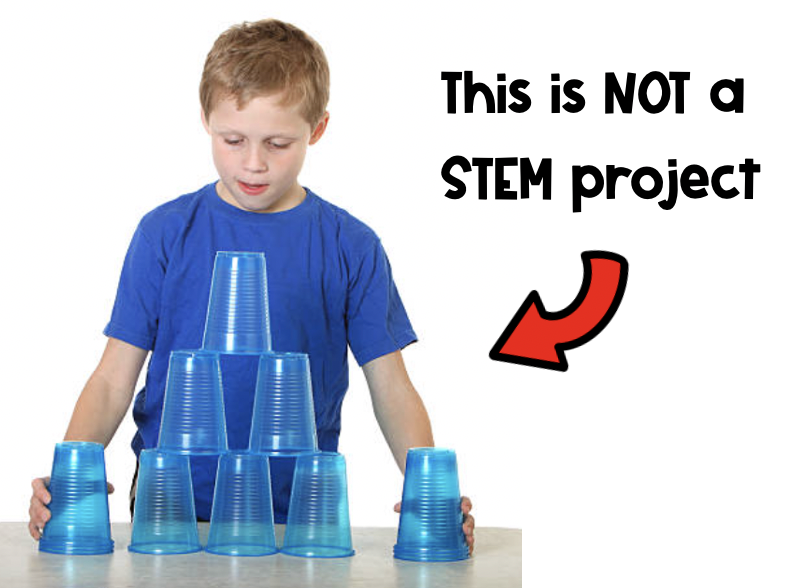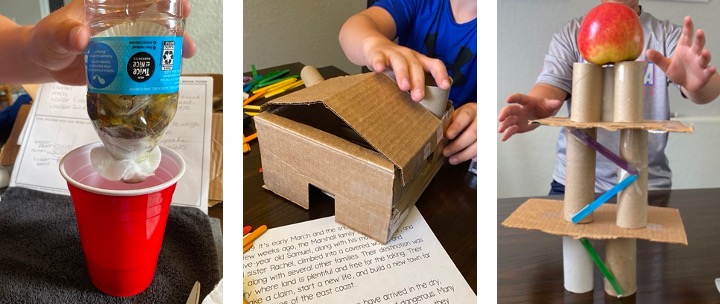
The Best STEM Challenges for Elementary Students in 3rd 4th and 5th Grade
I get a lot of questions about teaching STEM. What exactly is it? How do I start? Where do I get materials? How much time does it take? What are some easy STEM activities to start with?
Today I’m going to show you how to choose the best STEM challenges for 3rd, 4th, and 5th graders because finding a quality project is the most important step. After that, all the details will fall into place.
Why focus on 3rd, 4th, and 5th grade students, you ask? Well, most younger students aren’t quite ready for the full engineering design process – especially testing, evaluating, and revising. But they are definitely ready to explore science concepts and learn about the scientific method which are the building blocks of a real stem activity. So for those little learners in 2nd grade and below, a simple experiment is a great way to introduce them to the basics of science.
So how do you find good STEM lessons for your young scientists in upper elementary? Here are some things to consider before you get started:
.
STEM Challenges Must Have A Purpose
Just like in any other subject, when teaching STEM, your activities need to have a clear reason behind them. Here’s why:
- A reason gives you an end-goal and that is how you tell whether your students were successful or not.
- Learners who are given a meaningful reason for learning will naturally learn more.
.
Don’t spend valuable class time on something if you and your students don’t know WHY they are doing it.
.
Avoid “Fake” STEM Activities
What does that mean? You might be surprised to learn that not every activity labeled “STEM” qualifies. Just because your students design and build something doesn’t mean they are doing STEM. There are lot of fun projects that people call STEM that really aren’t worth the time from an educational standpoint. Here are some examples:
What STEM is not…
- STEM isn’t stacking a bunch of cups on top of each other to see who can make the tallest tower. That’s a fun activity or a contest.
- STEM isn’t making a butterfly with popsicle sticks and pipe cleaners. That’s an art project.
- STEM isn’t making a kaleidoscope out of a toilet paper tube. That’s a craft.
- STEM isn’t copying 3-D shapes with toothpicks and gumdrops. That is following directions.
.

“Whaaaaaaat?” you say. “But I see those things all over the internet!”
Yep, true… but they aren’t STEM. They don’t follow the engineering design process. Even a simple science experiment isn’t STEM.
.
Real STEM Is A Problem Solving Process
Now that you know what STEM is not, let’s think about what it is so you can plan some high quality and FUN stem activities for your students.
STEM involves many important concepts and problem-solving skills such as:
- identifying problems
- asking questions
- brainstorming
- planning
- designing
- testing
- revising
- predicting
- estimating
- measuring
- reflecting
.

.
It requires students to first identify something that needs to be fixed or solved. None of the examples I listed earlier present students with any kind of problem, and that goes back to point one… STEM activities for 3rd, 4th, and 5th graders need a clear purpose.
.
STEM Follows Specific Steps
A true STEM challenge follows the engineering design process. It doesn’t stop short. And what is that process?
- Define the problem.
- Brainstorm solutions.
- Plan your best solution.
- Make a model.
- Test your model.
- Reflect and revise your design.
- Test again.
- Share your results.
.
There are many STEM challenges for elementary students that stop after step 4. But is that what real scientists and engineers do? Of course not! They don’t stop without finding out if their ideas work and if their hypothesis was correct. So why should your students?
.
STEM is About Real-World Problems
Ideally, a STEM challenge will present students with a very clear problem to solve and something that makes them WANT to solve it. Knowing how their ideas might be applied in the real world can turn disinterested students into highly motivated problem solvers.
A good example is a house building challenge. Students could either…
- Build the strongest house they can or
- Design a house that can withstand hurricane force winds for a family living in Haiti
.
Now, which do you think is more motivating? Which has a clearer purpose? Which has specific requirements that could be tested? You know the right answer.
.

This set of STEM challenges share a common theme and purpose. Students must design items to help a stranded sailor escape from a deserted island.
Thematic STEM projects like these are very engaging for 3rd, 4th, and 5th grade students.
.
Here are a few other ideas that could be the basis for some excellent stem challenges:
- Design an effective method for cleaning up oil spills in the ocean
- Build a device that can remove fallen rock quickly after an earthquake
- Create a waterproof capsule that could be used to send supplies to a trapped submarine
.
Finding the Best STEM Activities
Now that you know what good STEM challenges for elementary students should include, it will be a lot easier to find or design one for your class. To help even more, I’ve designed this quick little checklist:
Does the challenge…
- Present students with a problem to solve?
- Include suggested materials?
- Have clear parameters or requirements?
- Require students to measure or test their results?
- Provide an opportunity to revise and retest?
.
If you can say yes to each item on the list, you know you’ve got a real challenge that will develop your students’ critical thinking skills.
I encourage you to steer away from the term easy stem challenge when searching for activities for elementary kids. The word easy tends to bring up fun activities that might involve a bit of science but don’t fit the criteria of STEM learning. There really is no such thing as simple STEM projects. If you’re going to do STEM, you want something that will challenge your young learners to think creatively and critically.
.
Preparing for Your STEM Challenge
Before incorporating STEM challenges for elementary students into your lesson plans, you’ll need to collect a variety of materials. Keeping a stash on hand makes doing engineering projects a lot less overwhelming.
Here are some ideas for materials that always come in handy:
- paper clips
- rubber bands
- string
- tape
- plastic spoons
- craft sticks
- newspaper
- cardboard
- paper towels
- plastic wrap
- paper cups
- aluminum foil
.
Your students will also need some tools like rulers or measuring tape, timer, scissors, and pencils. They can also use technology to research their ideas or gain background knowledge (like, how does a catapult work?), so tablets or laptops are helpful as well.
A good way to get basic supplies without spending a bunch of money is to just ask your students to bring some junk in from home. You can also send a letter to parents asking for donations of simple materials.
Here’s a free done-for-you parent letter that you can use to request supply donations for your STEM challenges – plus a STEM project planning sheet.
⏬ Download them from the Free Resource Library.

.
Now what are you waiting for? Get out there and start using STEM with your third, fourth, and fifth graders!
Looking to save time with some fully-planned STEM activities? Each of these sets includes 5 exciting challenges centered around an engaging theme. All the planning is done for you and the activities can be completed in collaborative groups or by individual students. Perfect for 5th graders!
.
Share it:
You might also like...






